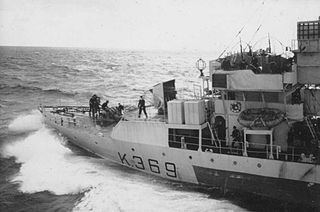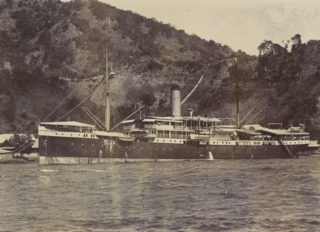HMS Audacity was a British escort carrier of the Second World War and the first of her kind to serve in the Royal Navy. She was originally the German merchant ship Hannover, which the British captured in the West Indies in March 1940 and renamed Sinbad, then Empire Audacity. She was converted and commissioned as HMS Empire Audacity, then as HMS Audacity. She was torpedoed and sunk by a German U-boat in late 1941.

The Castle-class corvette was an ocean going convoy escort developed by the United Kingdom during the Second World War. It was the follow-on to the Flower-class corvette, and designed to be built in shipyards that were producing the Flowers. The Castle-class was a general improvement over the smaller Flowers which were designed for coastal rather than open ocean use.
HMS Marigold was a Flower-class corvette of the Royal Navy. She was launched on 4 September 1940 and was sunk by an Italian air-dropped torpedo on 9 December 1942.

Pomone was a 40-gun frigate of the French Navy, launched in 1785. The British captured her off the Île de Batz in April 1794 and incorporated her into the Royal Navy. Pomone subsequently had a relatively brief but active career in the British Navy off the Atlantic and Mediterranean coasts of France before suffering sufficient damage from hitting a rock. Due to this, the ship was taken out of service and then broken up in 1803.
Britannia may refer to any one of a large number of ships:

HMCS West York was a Flower-class corvette of the Royal Canadian Navy which took part in convoy escort duties during the Second World War. Named after Weston, Ontario, she was built by Midland Shipyards Ltd. in Midland, Ontario and commissioned on 6 October 1944 at Collingwood.
HMCS St. Thomas was a Castle-class corvette of the Royal Canadian Navy. She served during the Second World War in the Battle of the Atlantic, taking part in the sinking of the German U-boat U-877 in 1944. Initially ordered by the British Royal Navy as Sandgate Castle, the ship was transferred to Canada before completion. Following the war, the corvette was converted for mercantile use and renamed Camosun III, then Chilcotin and Yukon Star in 1958 before being broken up in Washington in 1974.
Exeter was a three-decker East Indiaman built by Perry and launched in 1792. She made eight voyages to the East Indies for the East India Company (EIC). More unusually, on separate voyages she captured a French frigate and participated in the Battle of Pulo Aura. She was sold for breaking up in 1811.

Several vessels have been named Thames, for the River Thames:

HMS Vetch (K132) was a Flower-class corvette that served in the Royal Navy during the Second World War. After helping to escort many convoys and sinking two U-boats, she was decommissioned and sold in 1945.

HMCS Arrowhead was a Flower-class corvette that was originally commissioned by the Royal Navy but served primarily with the Royal Canadian Navy (RCN) during the Second World War. She fought in the Battle of the Atlantic and the Battle of the St. Lawrence as a convoy escort. The vessel was named for sagittaria, which is an aquatic water plant that is sometimes known as arrowhead. Following the war, the ship was sold for mercantile use as a whaling ship and renamed Southern Larkspur. The vessel was broken up for scrap in 1959.

SS Van Heemskerk was a passenger steamship that was launched in the Netherlands in 1909 and sunk by enemy action off New Guinea in 1943. She spent most of her career with Koninklijke Paketvaart-Maatschappij, based in the Dutch East Indies.

HMCS Hespeler was a Castle-class corvette of the Royal Canadian Navy which served during the Second World War as a convoy escort that was originally ordered as HMS Guildford Castle for the British Royal Navy but before completion was transferred and renamed. Following the war, the ship was sold for mercantile use, renamed Chilcotin in 1946, Capri in 1958, Stella Maris in 1960, and Westar in 1965. The ship was destroyed by fire in 1966 while at Sarroch, Sardinia. The hulk was taken to La Spezia, Italy where Westar was broken up.

HMS Woolvesey Castle, also spelled as Wolvesey Castle, was a Castle-class corvette constructed for the British Royal Navy during the Second World War. Before completion, the ship was transferred to the Royal Canadian Navy and was renamed HMCS Huntsville. Huntsville spent the rest of the war as a convoy escort. Following the war, the ship was converted for mercantile use and entered service as SS Wellington Kent in 1947. In 1951, the ship was renamed Belle Isle II. In 1960, Belle Isle II was sunk in a collision.
HMS Walmer Castle was a Castle-class corvette constructed for the British Royal Navy during the Second World War. Before completion, the ship was transferred to the Royal Canadian Navy and renamed HMCS Leaside. The corvette was used as an ocean convoy escort during the war and was sold for mercantile use following it. The ship was purchased for use as a passenger ship and renamed Coquitlam, then in 1958, Glacier Queen. In 1970 Glacier Queen was acquired for use as a floating hotel in Alaska. The ship sank in 1978 and was raised and scuttled in Alaskan waters in 1979.
Several ships have borne the name Caledonia for Caledonia:
Several vessels have been named Prince George:
MV Walmer Castle was a UK cargo liner. She was launched in 1936 in Northern Ireland, and was the smallest ocean-going ship in the Union-Castle Line fleet. For three years she provided a scheduled weekly cargo feeder service linking Union-Castle liners that terminated at Southampton with the German ports of Bremen and Hamburg.
Walmar Castle was launched in 1836 as an East Indiaman. She made 16 voyages two India, and at least two to Australia with migrants, and was sold about 14 October 1855. New owners then traded with China. She was last listed in 1867 with data unchanged since 1857.
Several ships have been named Mentor:
This page is based on this
Wikipedia article Text is available under the
CC BY-SA 4.0 license; additional terms may apply.
Images, videos and audio are available under their respective licenses.








